Malmö: Where indigenous birds mingle with global travellers
About the author:
Erik Hirschfeld is a well-known Swedish birder fortunate to live in Malmö. He is the author of several books, including The World’s Rarest Birds (2013) covering global bird conservation and Fåglarnas Malmö (2011), covering Malmö’s birds and their interaction with humans. He has served on bird record committees in Sweden, Jordan and the United Arab Emirates, and has been involved in several scientific expeditions, especially in the Middle East. Fifteen years ago he founded Vilda Malmö, initially a lose network of nature guides, in order to highlight Malmö’s natural environment to its residents. Today he spends his birding time between being an active bird bander, studying migration of seabirds, and running Scandinavia’s largest bird tour company, AviFauna. He frequently gives illustrated talks on birds to both beginners and professionals, and guides people interested in birds for Vilda Malmö.
A crossroads for migration
Perched at the southern tip of the Scandinavian Peninsula, Malmö offers migratory birds a convenient shortcut across the water to Denmark and mainland Europe. Much like the famed Falsterbo, just 30 km down the coast, Malmö is perfectly positioned along a major migratory route. When on the move, many landbirds avoid vast bodies of water and instead funnel through areas with shorter crossings. Add the iconic Öresund Bridge into the mix, and you’ve got a ready-made flight path. On windy days, birds of prey can often be seen using the bridge as a navigational aid during their spring and autumn journeys.
But geography alone doesn’t explain Malmö’s birding success. Migrants won’t stop unless there’s a good reason to. That’s where Malmö’s clever city planning and habitat diversity come into play. The city is a patchwork of microhabitats catering to a dazzling variety of birds with different needs.

Red-necked Grebes
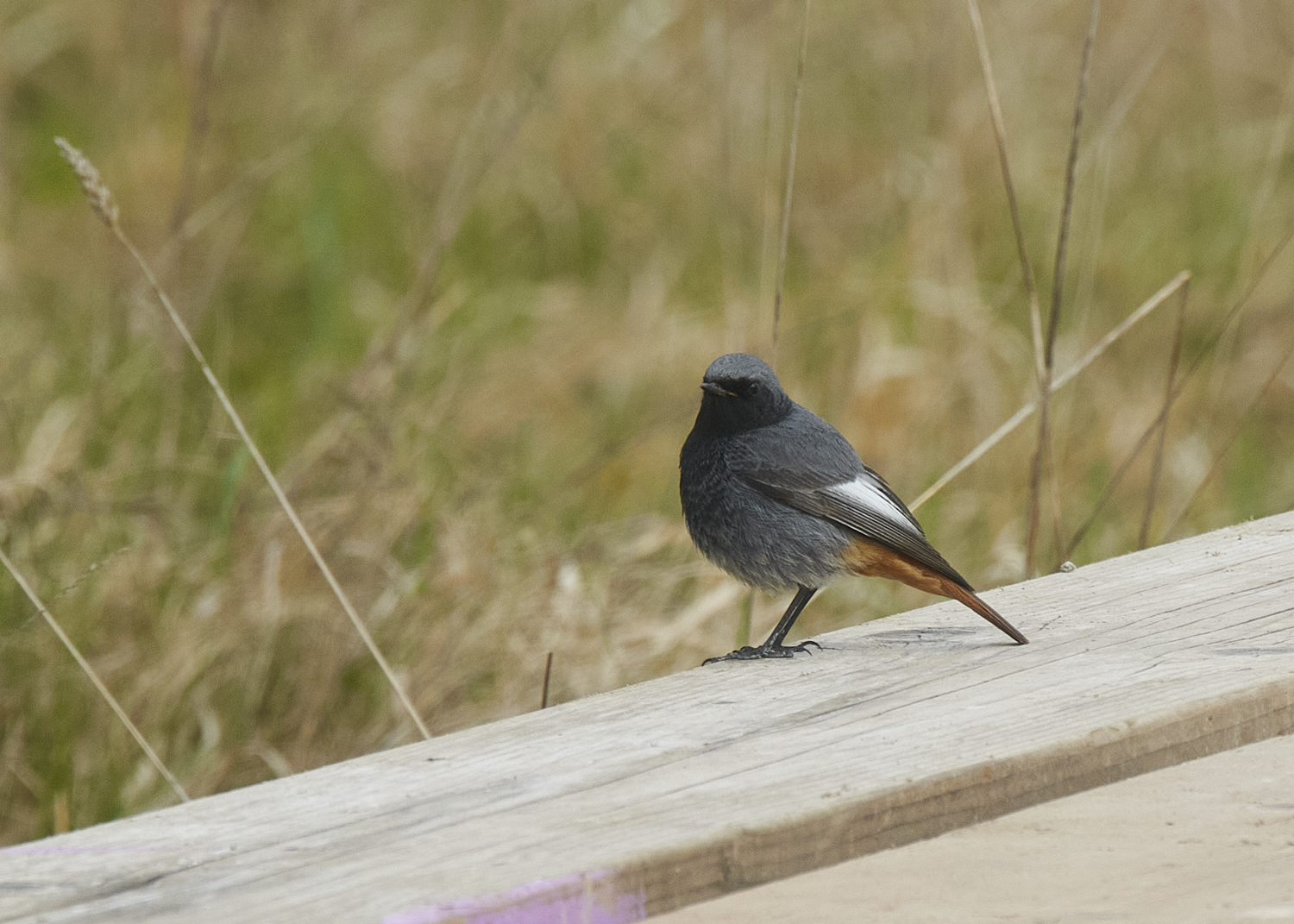

Black Redstarts (male & female)
Habitat hotspots and urban adaptations
Take the coastline, for instance. Stretching out in a mix of sandy, muddy, and rocky areas, it serves up a smorgasbord of habitats for wading birds, perfect for sanderlings, bar-tailed godwits, and purple sandpipers. In the harbour, boulders placed as wave-breakers become life-saving shelters for tired migrant passerines hiding from hungry sparrowhawks. Seabirds following the east-west coast are often seen rerouting dramatically to avoid land, providing unforgettable spectacles for those positioned at just the right windy vantage point. In fact, gannets now winter offshore in large numbers, mingling with massive flocks of cormorants. Two species of albatross have even made surprise appearances here, an astonishing rarity in these parts, and sooty shearwaters from New Zealand have become almost annual guests.
One of Malmö’s most productive hotspots is the stretch along Ribersborg Beach. Here, seaweed is cleared to please beachgoers and then dumped near a hedge by Lagunen harbour. That unassuming pile teems with insect life and sits beside a dense alley of trees, offering both food and shelter to weary warblers. Come migration season, that compost pile becomes a lifeline. It’s also the site of an ongoing bird banding project, and when the seaweed dries out, it’s used to fertilise Malmö’s public lawns, an example of ecology in action.
Inland, a series of freshwater ponds offers safe nesting and feeding areas to mute swans, little grebes, and the red-necked grebe, a striking species whose springtime courtship dances can be enjoyed up close, even without binoculars. These ponds give Malmö residents front-row seats to one of nature’s most theatrical performances.

Oystercatcher
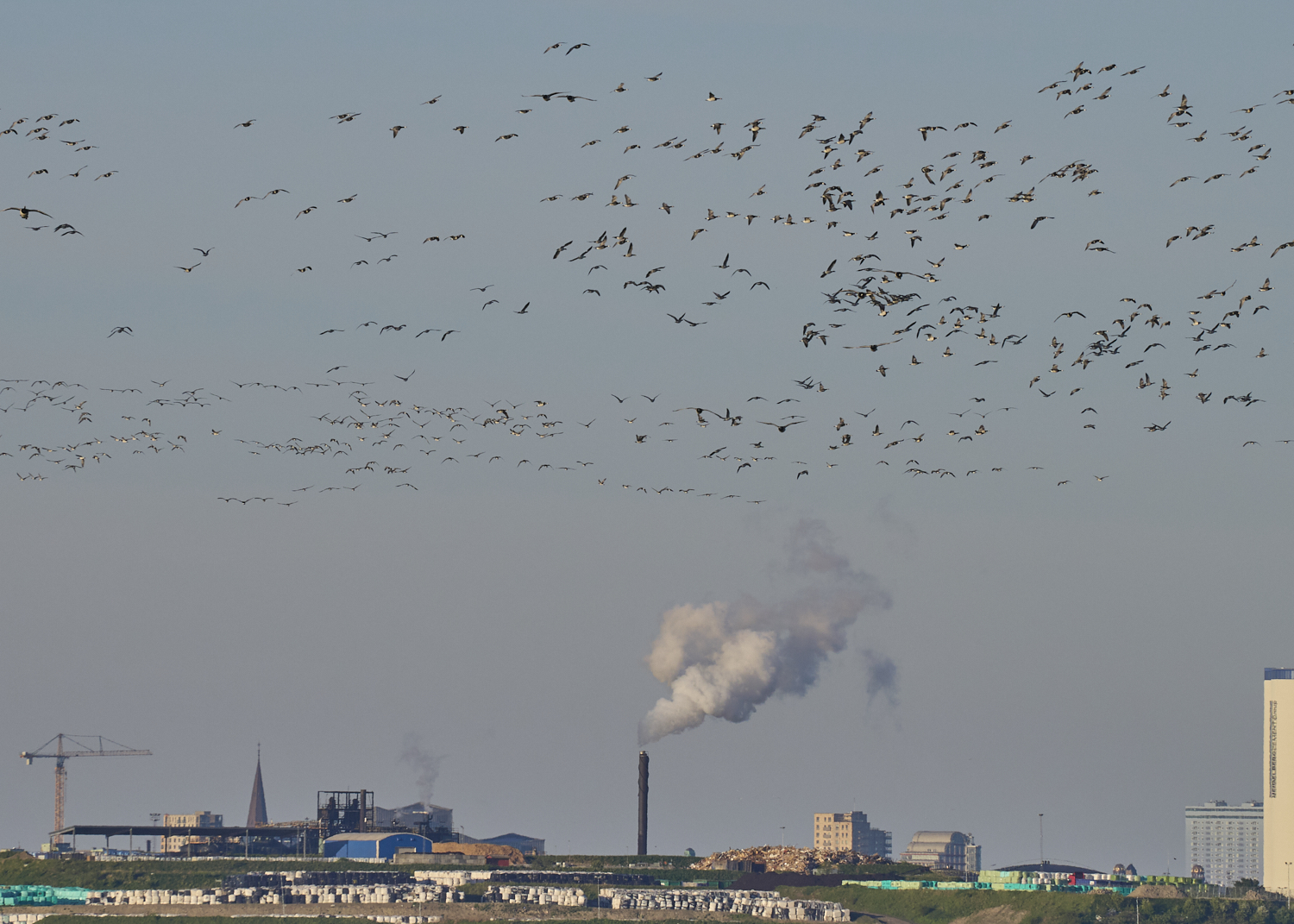
Barnacle Geese
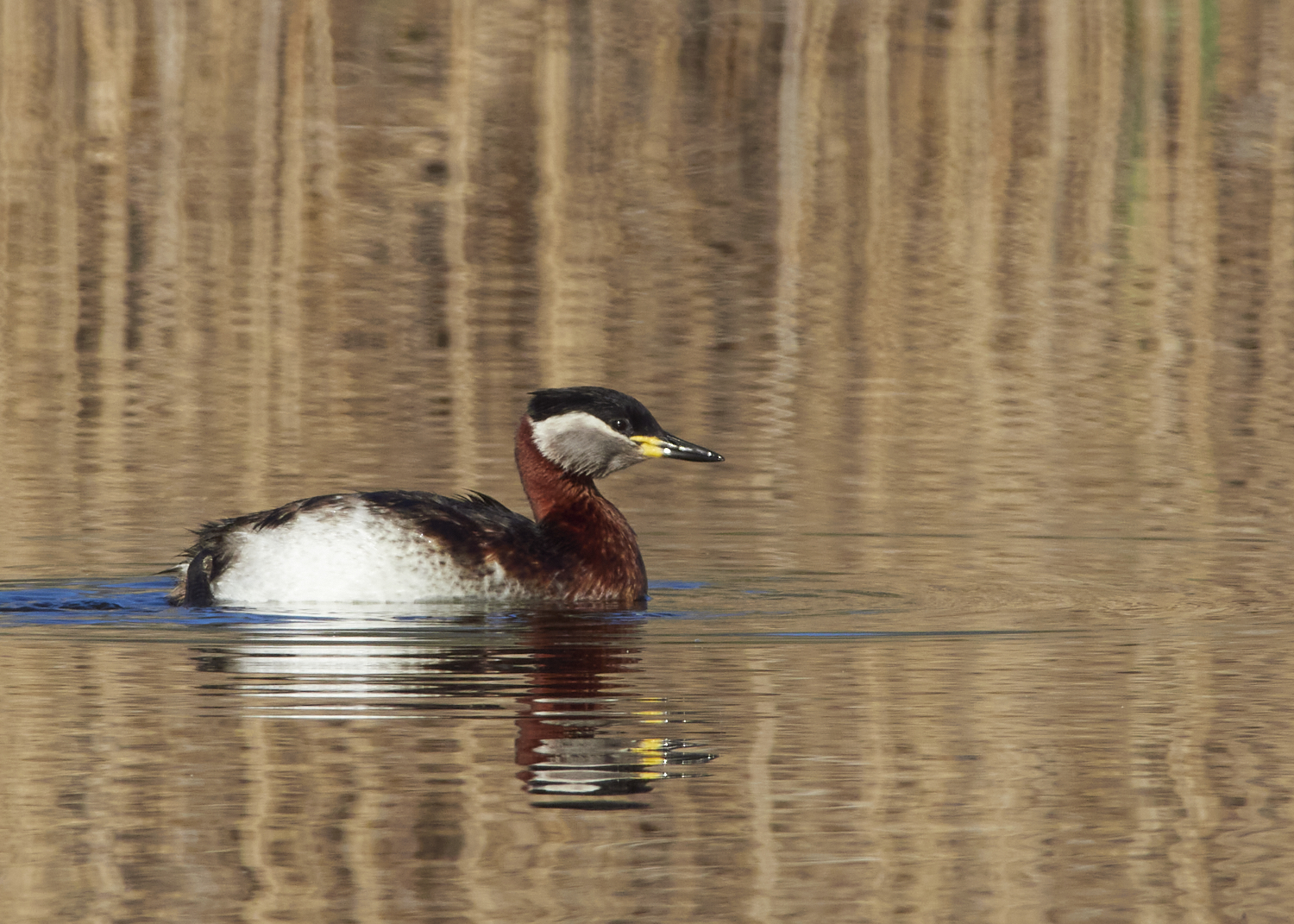
Red-necked Grebe

Common Gull

Barnacle Geese

Barnacle Geese with two rare Red-breasted Geese
Birds in the parks and cemeteries
Every spring, a headline act unfolds in the city. Ravens nest in an old shipbuilding crane beside a waterfront residential zone, an urban first in Sweden. Unlike the domesticated Tower of London ravens, these are wild birds, voluntarily choosing Malmö’s industrial relics as breeding grounds.
The city’s beloved parks are no less impressive. Hammars Park, with its wild undergrowth, attracts songbirds like blackcaps, wood warblers, and goldfinches. Pildammsparken, with its elegant promenade and wide pond, plays host to ducks, gulls, and breeding great crested grebes showing off their curious greeting displays in spring. It’s a favourite among preschoolers, grandparents, and birders alike, offering easy access and rich wildlife. Slottsparken, meanwhile, offers a blend of trees and water that appeals to both breeders and migrants.
In late morning, gulls descend from the coast to bathe in the parks’ freshwaters. Tufted ducks and common gulls, with nesting grounds as far away as Siberia, make Malmö their winter base. Come late February, they’re joined by the first migrant lesser black-backed gulls, newly arrived from central and eastern Africa. Meanwhile, black-headed gulls spend the colder months here after journeys from Finland and the Baltics. Banded individuals, some as old as 30, have revealed fascinating life histories stretching across multiple cities and countries. The combination of being raised and spending the winter in highly urbanized habitats seems to be favorable to longevity.
St Pauli Cemetery, oriented north to south, is another seasonal hotspot, especially in spring. Here, you might glimpse the cryptic wryneck or the elusive ring ouzel, more commonly found in the remote fjells of summer. Redstarts regularly nest here too, making the cemeteries a true urban oasis.
Rooftop nesters and winter guests
Even Malmö’s high-rises play a part. Districts like Västra Hamnen, Dockan, and Limhamns Sjöstad resemble mountainous terrain to birds like the black redstart, which now echo their melodic calls through Malmö’s urban canyons. Some individuals even winter here, finding refuge in the evergreen ivy on buildings near the central station, alongside European robins.
The charismatic oystercatcher also makes its urban presence felt. Arriving in late February, they roost in flocks on jetties used by swimmers in summer before fanning out to nest on flat rooftops. Common gulls, meanwhile, often share these rooftops, while house martins and common swifts each have their architectural preferences. Clay nests on high buildings suit the martins, while the swifts prefer roof tiles on villas in Malmö’s western suburbs.
And let’s not forget the barnacle geese. Once Arctic-bound migrants, they now breed in Malmö in huge numbers, a mix of introduced birds and natural colonists. In May, local geese look skyward as their distant cousins pass overhead in dramatic, noisy formations, en route between the Low Countries and their Novaya Zemlya breeding grounds. Some Malmö-born geese have even been spotted in the Arctic, and vice versa.

Oystercatchers
Of course, the benefits of this biodiversity aren’t just for the birds. Access to urban nature is known to boost human well-being, and Malmö makes it easy to connect with the wild. Through the Vilda Malmö (Wild Malmö) program, residents can join free expert-led tours covering birds, bats, trees, marine life, and more, kept to small, intimate groups. For those who prefer to look for urban wildlife on their own, there are information signs placed around the city, with photos or drawings of the local fauna.
Malmö’s love of birds runs deep. Even its bird alert app, usually the domain of avid birders, has over 1,000 subscribers, proving that in this city, the skies above are just as captivating as the streets below.
Korean local governments engage at CitiesWithNature capacity-building workshop
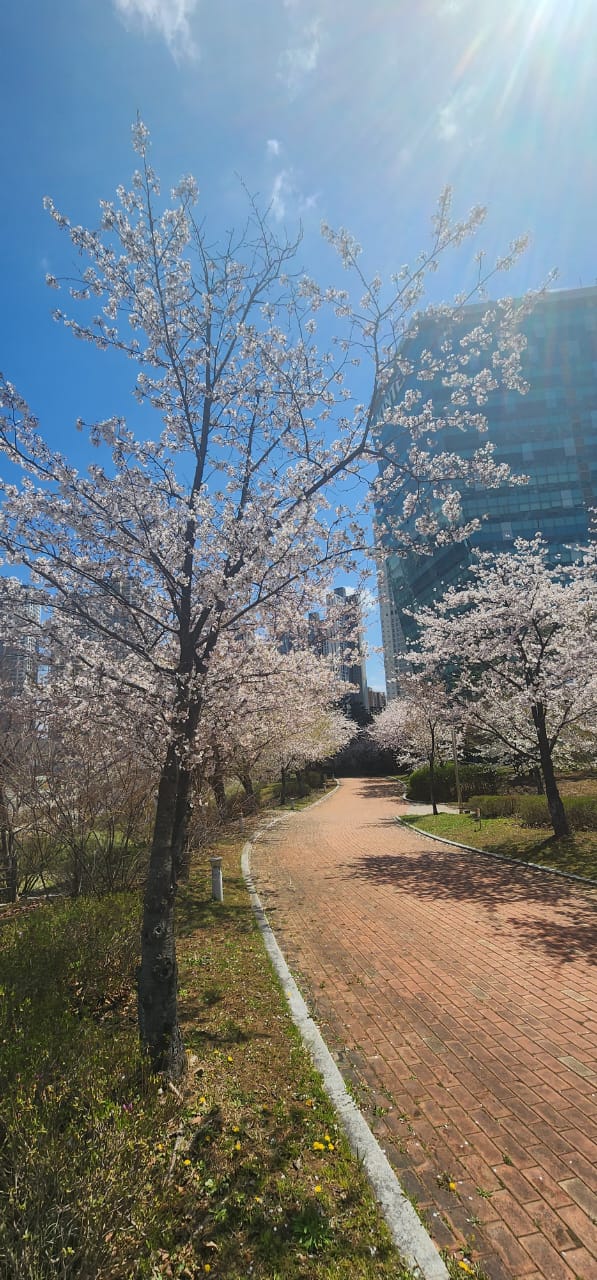
On Wednesday, 16 April, the ICLEI Korea Office took center stage at the “2025 World Local Government Climate Summit” with a special side event: the CitiesWithNature Capacity-Building Workshop for Korean Local Governments. This interactive session was designed to elevate understanding of the CitiesWithNature initiative and empower ICLEI member cities in Korea to fully engage with this pioneering platform. With around 13 local governments and institutions participating, the workshop spotlighted how local action can lead global change in biodiversity and nature-based solutions.
In her welcome address, Kobie Brand, ICLEI Deputy Secretary General, laid out ICLEI’s global vision for embedding biodiversity and ecosystem thinking into urban development. She traced the journey that led to the creation of CitiesWithNature, ICLEI’s flagship initiative, which envisions cities where nature and people thrive together. Emphasizing the importance of collective effort, Ms. Brand stated that no city can act in isolation. Building strong city partnerships, she said, is vital to secure a sustainable future for generations to come.
Recognized under the Convention on Biological Diversity (CBD), CitiesWithNature is not just another network, it’s a dynamic platform grounded in policy action and real-world implementation. Ms. Brand also considered the upcoming UNFCCC COP30 in Belém, Brazil, calling it the “Nature COP.” She underscored the urgent need to bridge the climate-biodiversity divide and placed local governments at the heart of this integration through CitiesWithNature.
“To act globally, it is important to build partnerships with local governments. CitiesWithNature will serve as a hub for collaboration and joint action between cities.”
~ Kobie Brand, Deputy Secretary General of ICLEI – Local Governments for Sustainability
Korean and Chinese cities take bold action in global biodiversity efforts
Highlighting regional momentum, Ms. Miyeon Yoo, ecological expert from Yeoncheon County, Korea, shared how her county’s UNESCO-designated areas are aligning with the CitiesWithNature movement. Guided by a vision of “conservation tourism,” Yeoncheon has crafted a unique governance model for managing the Imjin River, now both a UNESCO Biosphere Reserve and Global Geopark. The county runs a variety of conservation, ecotourism, education and culture programs, with a strong focus on biodiversity monitoring and youth engagement.
Since joining ICLEI in 2023, Yeoncheon has rapidly grown its international profile, co-hosting events like the “Yeoncheon UNESCO International Symposium for Future Generations” and featuring in the CitiesWithNature Guide Nature Values and Valuation for Cities. In 2024, the Imjingang River area was also designated as a Flyway Network Site under the East Asian–Australasian Flyway Partnership (EAAFP). Yeoncheon is now preparing to launch the Yeoncheon UNESCO Center, which will serve as a key base for expanding its nature-based development strategies and a model for other Korean cities.
From China, Ms. Ge Liu, Strategic Manager at the ICLEI East Asia Secretariat, highlighted the country’s leadership in biodiversity policy. As the co-host of CBD COP15, China elevated its “Ecological Civilization” strategy and rallied local governments across the country to join CitiesWithNature. Thanks to these efforts, 26 Chinese cities joined the platform following COP15 and COP16, with several recognized as “Biodiversity Charming Cities” for their leadership and innovation.
China’s strong presence at the 7th Summit for Subnational Governments & Cities, along with city-led events like “China Day,” demonstrates a powerful commitment to international biodiversity partnerships. Moving forward, Chinese cities are actively applying tools like the City Biodiversity Index (CBI) and Local Biodiversity Strategy and Action Plans (LBSAPs), with ICLEI support, to turn national ambitions into local action.
Unveiling the CitiesWithNature Action Platform Handbook: Empowering Korean local governments
Minwoo Chun of ICLEI Korea took the stage to introduce the practical tools and strategies available through CitiesWithNature. Chief among them is the Action Platform, a powerful mechanism that helps local governments align their goals with the Global Biodiversity Framework (GBF) adopted at CBD COP15. Through this tool, cities can declare nature-based commitments, set measurable goals, and transparently track progress, demonstrating the subnational push behind the global biodiversity agenda.
With the official launch of the CitiesWithNature program in Korea this year, ICLEI Korea is preparing a series of practical resources including issue briefs, dialogue reports, guides, and case studies designed to inspire and equip local policymakers. Best practices from Korean cities will also be amplified on the global stage through ICLEI networks, creating a cycle of learning and inspiration.
To support this evolution, ICLEI Korea is transforming its Strategic Planning Team into the “Climate and Nature Team” starting in 2025, signaling a deeper commitment to integrated action on climate and biodiversity. As implementation of both the Paris Agreement and the GBF accelerates, such convergence is no longer a choice – it’s a necessity. ICLEI Korea stands ready to champion biodiversity-forward cities through CitiesWithNature in the years ahead.

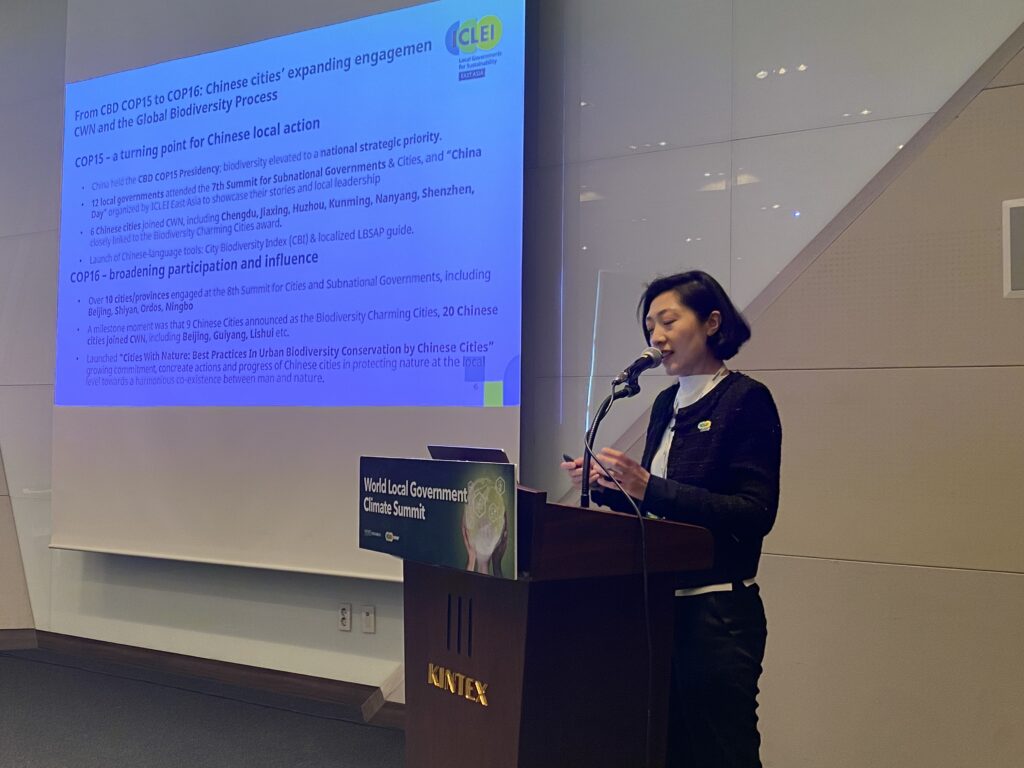


The UN Convention on Biological Diversity’s 15th Conference of Parties (COP15) from 7 to 19 December 2022 in Montréal provided the ideal opportunity for the CitiesWithNature and RegionsWithNature global partnership initiatives to highlight their notable progress in recent months.
CitiesWithNature has particularly experienced significant growth since its launch in 2018. During the 7th Summit for Subnational Governments and Cities at COP15, 36 new cities and five new global partners were welcomed to the CitiesWithNature global partnership initiative, which is recognized by the UN Secretariat of the Convention on Biological Diversity as the platform where subnational governments, cities and other local authorities report on their actions and voluntary commitments to the global biodiversity framework.

“By joining CitiesWithNature and using the Action Platform, cities across the world can commit ambitious actions that contribute to national and global biodiversity and nature goals, and easily track their achievements and actions individually and collectively. We strongly encourage all cities and regions, large and small, no matter where they are on their sustainability journeys, to join us and ensure we bring about the urgent transformative change that is needed!”
Kobie Brand, Deputy Secretary General of ICLEI - Local Governments for Sustainability and Regional Director of ICLEI Africa.
The sister platform to CitiesWithNature – RegionsWithNature – which focuses on subnational governments at the regional level and across urban-rural linkages, was officially launched on 12 December at the 7th Summit. During the CitiesWithNature and RegionsWithNature Announcement Ceremony, eight new subnational governments and two new global partners were welcomed on board.
“Launching RegionsWithNature, together with some of the most powerful subnational leaders in the world, sends a powerful signal to the planet, and especially to the Parties of the Convention. Subnational governments are committed, they’re ready, and they’re already playing an important role in implementing concrete actions on the ground.”
Jordan Harris, Executive Director of Regions4

New cities, regions and partners joining CitiesWithNature and RegionsWithNature at the 7th Subnational Governments and Cities Summit


NEW CITIES
City of Oakland, USA
City of Santa Monica, USA
Lake County, USA
City of Carbondale, USA
San Francisco, USA
City of Boulder, USA
City of Boston, USA;
Sainte-Anne-de-Bellevue, Canada
City of Laval, Canada;
Cartagena das Indias, Colombia
Autonomous Decentralised Municipal Government of Pastaza Cantón, Colombia
Alcaldía de Barranquilla, Colombia
Metropolitan Area of Aburrá Valley, Colombia
City of Roseau, Dominica
City of Portsmouth, Dominica
City of Utrecht, Netherlands
City of Paris, France
City of Marseille, France
Iringa Municipal Council, Tanzania,
Kisii County, Kenya,
Tswelopele, South Africa
Waterberg, South Africa,
Kampala, Uganda
Mukono Municipal Council, Uganda,
The District Council of Black River, Mauritius,
Hargeisa Municipality, Somalia,
Chengdu, China
Huzhou, China
Jiaxing, China
Kunming, China
Nanyang, China
Shenzhen, China
City of Nagoya, Japan
Chiang Mai, Thailand
Caygan de Ouro, Philippines
Mashhad Municipality, Iran

NEW REGIONS
La Rioja, Spain
Basque country, Spain
Aland islands in Finland
California in USA
Rio de Janeiro, Brazil
Paraná in Brazil
Guanajuato, Mexico
Jalisco in Mexico
New partners
The United Nations Economic Commission for Europe (UNECE)
WHO (World Health Organization)
CC35 (Capital Cities of the Americas)
CitiesWithNature and RegionsWithNature:
The Convention on Migratory Species (UN CMS)
R20 (Regions of Climate Action)
"Thank you for being part of the two Platforms, which give us the space to act together. As Nature is our home so are CitiesWithNature and RegionsWithNature."
Stefania Romano, Global Coordinator of CitiesWithNature and RegionsWithNature

Why are CitiesWithNature and RegionsWithNature important?
Knowledge sharing
CitiesWithNature and RegionsWithNature provide educational resources to ensure that cities are equipped with the knowledge and understanding of natural resources and ecosystems required to ensure that these issues are included in the cities and regions’ goals and planning.
One of the primary goals of these platforms is to keep city officials updated on best practices and lessons learned about important biodiversity topics, predominantly through the Tools and Resources section, but also by connecting cities and regions with one another. Connecting subnational and local governments facilitates much-needed collaboration across all levels of government to achieve the biodiversity goals as captured in the newly adopted Kunming-Montreal Global Biodiversity Framework.
“We need to strengthen our collaboration, our network, our initiative in conservation to maximize the solutions which work, through the platforms CitiesWithNature and RegionsWithNature.”
Benoit Charette, Minister of Environment, the Fight against Climate Change, Wildlife and Parks Québec

With 373 scientifically robust resources – including reports on topics such as nature-based solutions, ecosystems, health and well-being, and biodiversity governance, the Tools & Resources section empowers cities and regions with current and updated information on best practices.
CitiesWithNature offers Guides that package science-based information in a way that is easy to understand and accessible to cities. During COP15, CitiesWithNature announced that its Guide on light pollution, created in collaboration with the UN Convention on Migratory Species, will be launched soon.
In 2022, CitiesWithNature created its first Community of Practice – which is a platform aimed at connecting cities to learn from one another, by predominantly utilizing its chat function. The platform also aims to bring together the broader community of researchers and practitioners to connect with cities to solve biodiversity-related challenges. The first Community of Practice was launched for coastal cities, in collaboration with the Western Indian Ocean Marine Science Association (WIOMSA).
Knowledge sharing has been facilitated through a range of tools and activities including targeted campaigns, news and updates, as well as webinars to empower cities with the knowledge of how to use the Action Platform. CitiesWithNature also uses its newsletter – the Buzz – to keep cities updated with current events, news and important information, while also profiling the achievements of CitiesWithNature cities and RegionsWithNature regions in achieving their biodiversity targets.
During the 7th Summit for Subnational Governments and Cities, Regions4’s Case Study Database, one of RegionsWithNature’s new tools, was launched. The Database is a freely accessible open source online database that showcases the subnational government experience. Currently eight case studies from six regions – Québec, Catalonia, the Basque Country, Lombardy, Jalisco, and Aichi – are available in Spanish, French, and English. Its goal is to build and develop capacities at the regional level of government, transforming on-the-ground knowledge into best practice learning opportunities in support of the implementation of the Kunming-Montreal Global Biodiversity Framework.
Monitoring and reporting
While RegionsWithNature was only recently launched, CitiesWithNature already has an established range of tools for monitoring and reporting on cities’ biodiversity actions. Notably, the CitiesWithNature Action Platform is used to feed local and subnational level actions for biodiversity into national biodiversity planning. The action areas, commitments, actions and targets are all linked with the Sustainable Development Goals and Global Biodiversity Framework targets to ensure they align with national priorities.
This is supported by the Nature Pathway – guiding cities step by step to promote and mainstream nature into their policy, planning and actions.
During COP15, CitiesWithNature also launched the digitized version of the City Biodiversity Index, also known as the Singapore Index, which is based on the updated version of the CBI handbook. The automated calculations of this digitized version help cities establish a baseline for biodiversity to further monitor and report on their biodiversity, for example by making commitments and setting targets on the Action Platform.
Through this monitoring and reporting function, CitiesWithNature also plays a role in mobilizing the subnational and local governments Major Group by leading and providing support to critical advocacy events such as the 7th Summit and its associated Pavilion at COP15.

“CitiesWithNature and RegionsWithNature are recognized in the Plan of Action as being the place where subnational governments and cities can report on their commitments towards contributing to national and global biodiversity targets and track their progress, and I am really hoping to see many more commitments made on these platforms.”
Ingrid Coetzee, Director: Biodiversity, Nature & Health, ICLEI Cities Biodiversity Center
To encourage cities to make use of the Action Platform, CitiesWithNature employs a reward system that acknowledges and celebrates cities’ commitments. This includes certificates, reward badges and rankings that appear on City Profiles and can be downloaded as pdfs for cities to share and keep track of their progress.
In addition to all the functionalities mentioned above, CitiesWithNature will also launch its Community and Research Hubs in the near future to further connect cities, researchers and practitioners.
Watch the ICLEI Cities Biodiversity Center video featuring voices from across the world calling for cities to become CitiesWithNature here.
Center of Excellence launched at COP15
The ICLEI-Kunming International Center of Excellence for CitiesWithNature, jointly initiated by ICLEI and Kunming City, was formally established at a signing ceremony during the 7th Summit on 12 December. The center is committed to be an important platform for demonstration, peer learning and creating partnerships between Chinese and international cities on nature conservation and biodiversity. It will also help enhance local governments’ technical capacity and encourage local commitment and actions for the implementation of the newly adopted Kunming-Montreal Global Biodiversity Framework. The activities of the center will run in close collaboration with ICLEI Cities Biodiversity Center based in Cape Town, South Africa.

MEDIA RELEASE
ICLEI, together with its partners, invites subnational and local governments to Montréal, Québec, Canada for the 7th Summit for Subnational Governments and Cities and its associated Pavilion. The Summit, an official parallel event to the 15th Conference of the Parties (COP 15) to the CBD, will be co-hosted with the Secretariat of the Convention on Biological Diversity (SCBD) and Regions4, along with the host Government of Québec and the City of Montréal. Both the Summit and the Pavilion are financially supported by the Government of Québec as main sponsor.
For the first time at a CBD COP, there will be a dedicated Pavilion, focusing on subnational government and city actions and opportunities. This clearly demonstrates an elevated recognition and the biodiversity community of the significant contributions of local and subnational governments towards the implementation of the global biodiversity framework (GBF).
Image provided by: Ezjay/Shutterstock.com

"It is with great pride that we welcome you to Québec for the 15th Conference of the Parties on Biological Diversity. Through its role as coordinator of the Advisory Committee on Subnational Governments and Biodiversity together with Regions4, Québec is committed to doing everything possible to promote the adoption of an ambitious Global Biodiversity Framework which, we hope, will pave the way for a new era of collaboration. We invite subnational you to participate in large numbers in the 7th Summit for Subnational Governments and Cities and to make your voice heard at this historic meeting."
Jean Lemire, Envoy for Climate Change, Northern and Arctic Affairs
The Summit and Pavilion constitute an unprecedented global milestone to welcome significantly strengthened contributions from subnational governments and cities to the new post-2020 GBF. The Summit, focused on taking action for biodiversity, will be held on 11th and 12th December 2022 at the Palais des Congrès (blue zone) and will center around three elements: Engage, Influence and Act.
The Pavilion program will include multiple events, from 8th to 18th December, during COP 15.
“Cities are essential leaders in the fight against climate change, the protection of biodiversity and the adaptability of our territories. They already experience the impact of environmental issues, they understand the major challenges that lie ahead, as well as the solutions to be implemented. As the mayor of Montréal and ICLEI global ambassador for local biodiversity, I am very happy to welcome the 7th Summit for Subnational Governments & Cities: Taking Action for Biodiversity.”
Valérie Plante, Mayor of Montréal & ICLEI global ambassador for local biodiversity.

This 7th Summit will provide a unique opportunity to address the targets and actions of the new GBF such as reducing threats to biodiversity, meeting people’s needs through sustainable use and benefit-sharing of biodiversity and ecosystem services, as well as implementing local and regional tools and solutions. The Summit is dedicated to taking action and making commitments, with subnational governments and cities sharing and demonstrating inspirational biodiversity initiatives, solutions and achievements, and pivoting combined multi-level ambitions and engagement into measurable actions. The outcome of this historic, action-oriented Summit will be presented formally by the hosts to the CBD COP 15 High Level Segment as a united message from the subnational constituency.


“As we approach COP 15 in Montréal this December, I am encouraged by the decision-makers of such authorities who are transforming the ways in which our economies affect biodiversity and move us towards whole-of-government, whole-of-society, approaches to ensure a sustainable future."
Elizabeth Maruma Mrema, Executive Secretary of the UN Convention on Biological Diversity.
The Summit will announce, solidify and celebrate subnational and local actions for the protection, restoration and enhancement of biodiversity across the world, actions that reconnect communities with nature for a more sustainable future. It will present new projects and multilateral announcements, and profile initiatives such as the global CitiesWithNature and RegionsWithNature partnership, which provide a platform for local and subnational governments to commit and share their ambitious actions and initiatives for and with nature, in measurable ways.
“Our planet can no longer support the inefficient misuse and management of our natural resources. The loss of biodiversity across the globe is inextricably linked to the acceleration of the climate crisis and the nature-based systems we rely on to help sustain our communities and way of life. Local governments will no longer tolerate being forced to confront this climate emergency alone. We should join CitiesWithNature and RegionsWithNature to convene and share our actions across all levels of government. And we should show the leadership needed in this now-or-never moment to safeguard a biodiverse, 1.5-degree world where all life can thrive. Together, we welcome a strong framework coming out of the UN Biodiversity COP15 conference to give us the momentum and guidance to act.”
Mayor Frank Cownie, City of Des Moines, Iowa & President of ICLEI-Local Governments for Sustainability.

The 7th Global Summit is convened by ICLEI, and co-hosted with the Secretariat of the Convention on Biological Diversity (SCBD) and Regions4, along with the host Government of Québec and the City of Montréal. This milestone Summit and Pavilion are supported by the Government of Québec, as main sponsor, and will welcome Parties, subnational governments, cities, their leaders, networks and partners from across the world to contribute and actively participate – in person or virtually.
COP 15 is hosted by the Government of China, and as the province of Yunnan, Kunming City, and China Environment News, in coordination with ICLEI East Asia Secretariat and the Ministry of Ecology and Environment of China, have contributed to the COP since its first phase, their role is acknowledged as supporting institutions to the 7th Summit.
Summit registrations are open at cbc.iclei.org or email biodiversity@iclei.org for more information.
Images provided by: Ville de Montréal
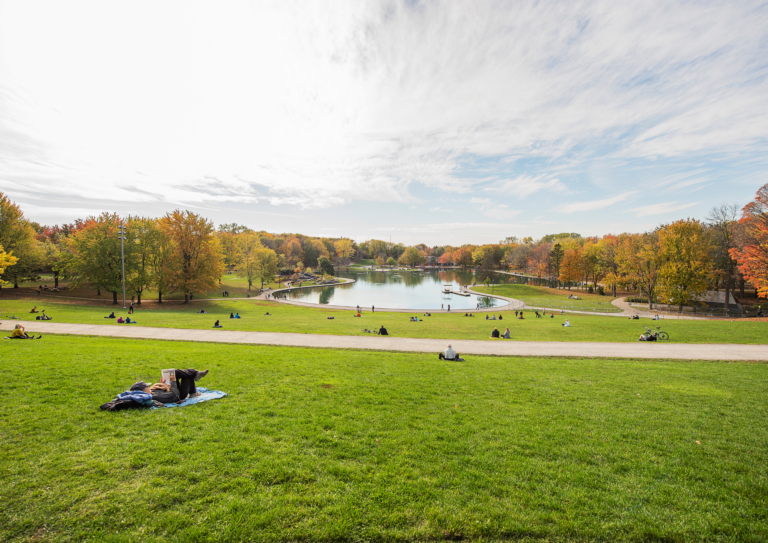

On 18 July, renowned Italian astronaut Samantha Cristoforetti took CitiesWithNature – the global urban nature partnership initiative – to the stars, by posting a tweet from SPACE to highlight the importance of urban biodiversity and ecosystem restoration.

About AstroSamantha
Samantha Cristoforetti, aka AstroSamantha, is a renowned Italian astronaut in the European Space Agency. In 2001, Samantha joined the Italian Air Force, and was selected as a European Space Agency astronaut in May 2009. On 23 November 2014, Samantha was launched from the cosmodrome of Baikonur in Kazakhstan, and returned to Earth on 11 June 2015, after spending 200 days in space. The mission, which was given the name Futura, was the second long-duration flight opportunity for the Italian Space Agency, and the eighth for an ESA astronaut.
In 2019, Samantha served as commander for NASA’s 23rd Extreme Environment Mission Operations (NEEMO23) mission during a 10-day stay in the world’s only undersea research station, Aquarius. Samantha returned to the International Space Station for her second mission, Minerva, on 27 April 2022. She was launched in a new SpaceX Crew Dragon capsule named Freedom alongside her Crew-4 crew mates, NASA astronauts Bob “Farmer” Hines, Kjell Lindgren and Jessica “Watty” Watkins.


Samantha is a UNICEF ambassador and donates to UNICEF the proceeds from sales of her memoir Diary of an Apprentice Astronaut, in which she shares her experience of being selected as an astronaut and then training for and flying her first space mission.
AstroSamantha called for proposals on impactful biodiversity and ecosystem restoration work across the globe that is visible from SPACE so that she could highlight the value of nature and the importance of protecting biodiversity during her mission. ICLEI partnered with the City of Cape Town, a long-standing Member and pioneer CitiesWithNature city, and asked AstroSamantha to feature the incredible work that is being done in the Blaauwberg Nature Reserve, while also calling on all cities to join CitiesWithNature and strengthen action through collaboration! On 18 July, the following Tweet circulated the globe, directly from Mission Minerva, reaching AstroSamantha’s 989.6k followers:
The space-based tweet highlighted the progress made through the Blaauwberg Large-scale Sand Fynbos Restoration Project in Cape Town. Cape Town is the most biodiverse city in the world, famous for its amazing variety of plants, collectively known as Fynbos. Cape Flats Sand Fynbos is a critically endangered habitat type, intrinsically rich in biodiversity, and found only within the city. The area being restored in Blaauwberg Nature Reserve was highly degraded and covered in dense woody alien invasive species. Besides having immense ecological importance, this area is also historically and socially significant. This restoration project is a prime example of collaboration and co-learning between researchers at a local university and City of Cape Town management, with external funders. Besides its ecological successes and lessons learnt, this project has produced a range of research projects and scientific papers on the various methodologies tested and employed, making it a great case study for other cities across the globe. The restoration project started in 2012 and is ongoing.
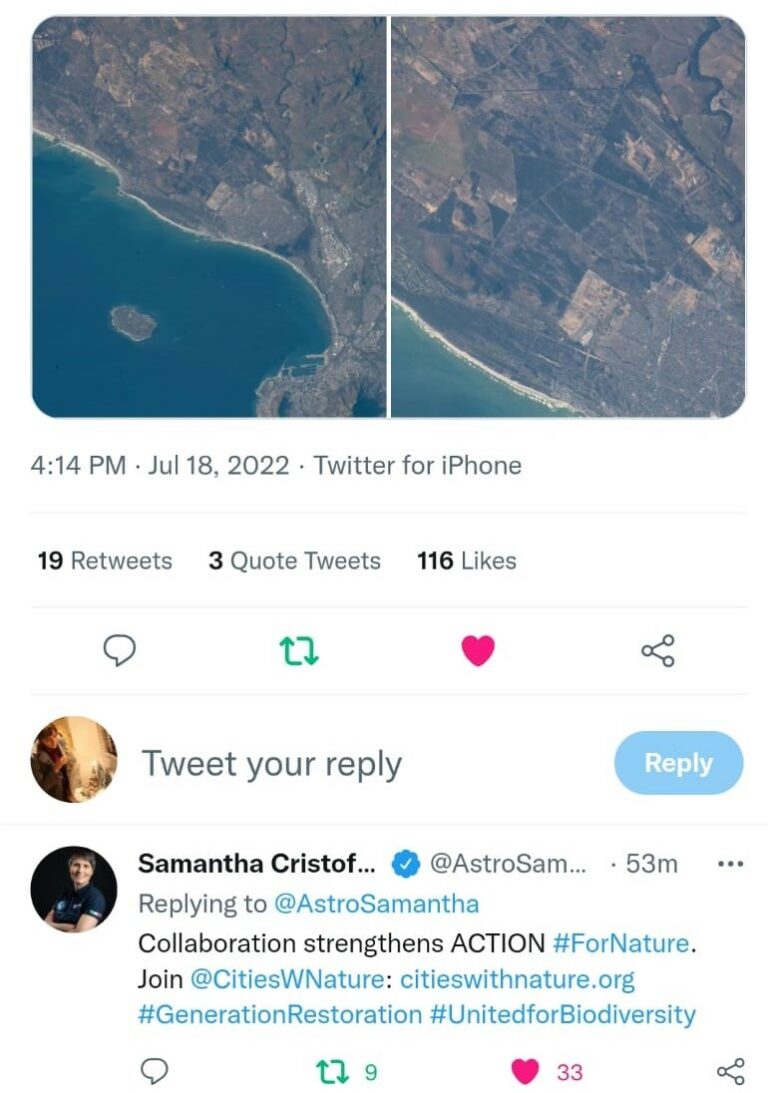
Why urban ecosystem restoration?
The total area covered by the world’s cities is set to triple in the next 40 years as millions of people continue to move into cities each week. Cities, regions and towns can control the way they change and grow, through a nature-positive approach. Collaboration across cities globally, and with all stakeholders, are essential to protecting biodiversity, restoring ecosystems, providing safe and accessible green open spaces, and reconnecting people with nature. CitiesWithNature, like Cape Town, are reaching for the stars and leading the way in restoring biodiversity and reconnecting their communities with nature. Restoring biodiversity can restore hope, and will help make cities sustainable and resilient through the ecosystem services provided by nature. Cape Town is one of the first hundred pioneer cities of the global CitiesWithNature initiative – which has now reached over 200 cities committed #ForNature. CitiesWithNature provides the UN Biodiversity-recognized platform that secures collaboration to strengthen the necessary actions to ensure that we have a bright, green future at peace with nature.
The UN Ocean Conference, co-hosted by the Governments of Kenya and Portugal, took place between 27 June and 1 July 2022 in Lisbon, Portugal, and culminated in delegates adopting a political declaration titled ‘Our Ocean, Our Future, Our Responsibility’.
The conference brought together national and local governments, UN agencies, and multiple stakeholders across different sectors to explore and identify solutions aimed at finding major structural transformations and common shared solutions, to be anchored in the SDGs.
Under the theme ‘Scaling up ocean action based on science and innovation for the implementation of Goal 14: stocktaking, partnerships and solutions’, discussions focused on leveraging interlinkages between Sustainable Development Goal 14 (SDG 14 – Conserve and sustainably use the oceans, seas and marine resources for sustainable development) and other SDGs towards the implementation of the 2030 Agenda for Sustainable Development. Throughout the conference, the linkages between SDG 14 and goals related to clean water and sanitation, poverty, food security, health, women, decent work, climate action, cities, terrestrial ecosystems, and partnerships were emphasized.
Jessie Turner, Director of the International Alliance to Combat Ocean Acidification (OA Alliance) captured the importance of urgent action for oceans: “When talking about climate change impacts on our ocean, we must be clear that while we don’t know everything, we know enough to act. We know enough to begin prioritizing and exploring the key questions that are most important to policy makers, seafood industries and coastal communities. And the good news is…we have lots of existing frameworks across different scales of governance that can be leveraged to take up this work.”
ICLEI – Local Governments for Sustainability and ICLEI’s Cities Biodiversity Center was represented by Kate Strachan – Manager, Climate Change Resilience, ICLEI Africa, and Stefania Romano – Global Coordinator for CitiesWithNature and RegionsWithNature, Recruitment and Advocacy.
During an interactive dialogue titled ‘Leveraging interlinkages between Sustainable Development Goal 14 and other Goals towards the implementation of the 2030 Agenda’, ICLEI emphasized the need for cities to learn from one another and apply these lessons and practices to protect, manage and restore vulnerable urban coastal ecosystems. To achieve this, CitiesWithNature and RegionsWithNature are international partnership initiatives providing a platform to connect local and subnational governments globally with NGOs, experts and communities to act for nature.
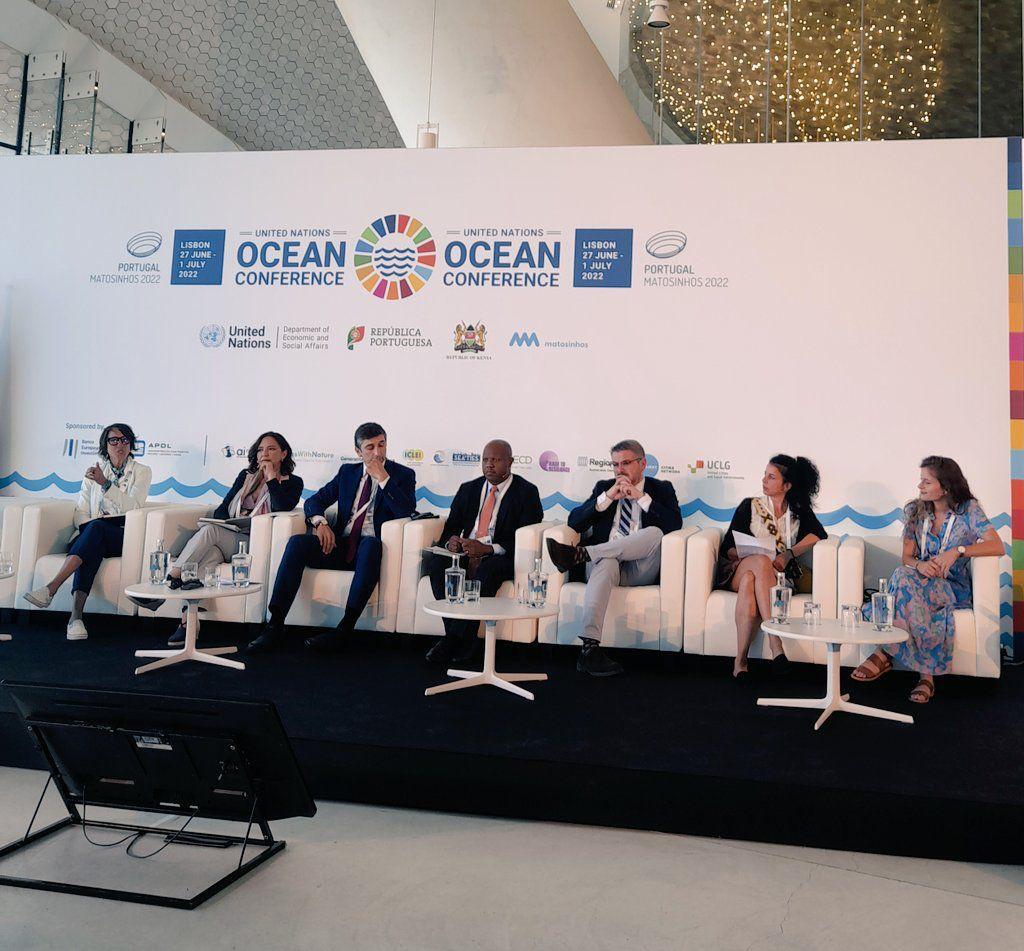


By 2025, nearly 6 billion people will live within 200 km of a coastline. Population growth and climate change-related impacts are increasing coastal risks and degrading coastal ecosystems upon which millions depend. Climate change impacts also compound existing pressures, such as pollution from land-based sources, ocean acidification and overfishing. Coastal cities and regions have unique opportunities to mobilize and demonstrate leadership in taking action to protect our ocean and ensure that the ocean and its accompanying coast are sustainably managed.
“It has never been as urgent as it is today to restore damaged ecosystems,” Stefania said. “SDG 14 offers a great opportunity to advance ocean sustainability globally and address current and emerging threats.” The goal is underpinned by targets addressing the conservation and sustainable use of the ocean, seas and marine resources – including coastal zones – and capacity building for ocean governance. In addition, SDG 14 supports the achievement of SDGs related to poverty alleviation, food security, sustainable blue/ocean economy, and climate change.
ICLEI was involved in a number of sessions and played a role in bringing to the forefront the role of subnational governments in ocean governance. As evident during the conference, both national and subnational governments are leading the way, taking domestic and international actions that expand climate-ocean policy and financing for this work.
Organizations and partnership initiatives such as ICLEI, CitiesWithNature and RegionsWithNature can facilitate learning from coastal city leaders, while simultaneously seeking deeper integration across climate, ocean and biodiversity commitments. These efforts will advance actions that address climate change, support food security and sovereignty, and increase resilience of marine ecosystems, economies, and communities.
Despite the delays in pivotal ocean and climate convenings and benchmarks as a result of Covid-19 restrictions, the UN Oceans conference sparked momentum once again, through the notable outcome of the 2022 UN Oceans Conference – the ‘Our Ocean, Our Future, Our Responsibility’ declaration.
Matosinhos side-event
Prior to the official Conference, a Special Event on ‘Localizing Ocean Action’ was held in Matosinhos (Porto) on 25 of July, convened by the co-hosts of the 2022 UN Ocean Conference, together with the City of Matosinhos, and organized in collaboration with UN DESA, UN Global Compact, the Climate Champions Team, the Global Taskforce of Local and Regional Governments, ICLEI, Regions4 Sustainable Development, Ocean & Climate Platform (OCP), United Cities and Local Governments (UCLG), Resilient Cities Network, the International Association of Cities & Ports (AIVP) and OECD. The special session highlighted urban-ocean linkages, specifically around marine plastic pollution, blue finance, local community development, human rights-based approaches towards transformation, and SDG 14 and the Post-2020 Global Biodiversity Framework. The special event also covered the role of local and regional governments to engage in global efforts and decisions to protect the ocean and maritime resources. The outcomes from the special event were conveyed during the main UN Ocean Conference.
ICLEI and the OCP co-organized Local Ocean Action Session 1, titled ‘The clock is ticking: How can coastal cities build resilience and incorporate nature-based solutions to protect local populations?’ This session focused on the importance of investing in innovative sustainable solutions, particularly nature-based ones, to combat the impacts of climate change, such as flooding, coastal erosion and rising sea levels. Speakers were invited to share innovative practices implemented by cities and regions. The panel was moderated by Kate Strachan, while Stefania Romano presented CitiesWithNature and RegionsWithNature as the Convention on Biological Diversity-recognized international partnership initiatives providing a platform and connecting local and subnational governments acting for nature. The side-event resulted in the Municipality of Matosinhos joining CitiesWithNature.
Session key messages included
- Coastal territories adaptation has to be considered at a larger territorial scale. From megalopolis to secondary cities and small towns, the more vulnerable urban areas have to collaborate at the regional scale to better design sustainable coastal adaptation strategies. It is crucial to reinforce cooperation at every level and encourage a “whole-of-society” approach.
- Climate coastal adaptation is changing towards a new sustainable paradigm. There is no one-fit-all solution. Managed retreat, nature-based solutions, hard and soft coastal protection, technical innovations, early warning systems, raising awareness, and education are all relevant responses that have to be combined, considering the local context.
- Key coastal stakeholders all have to be engaged in the global coastal transition for a sustainable blue economy, a well-adapted coastline and an equitable future. Local decision makers, populations, civil society, ports, tourism sector and privates should all be part of a co-construction process.
- Coastal adaptation and resilience has to include societal issues. Many communities have a difficult time securing funds and techniques for equitable coastal resilience. Targeting youth and women in terms of livelihood, coastal adaptation might be an opportunity to reduce poverty and social inequalities.
ICLEI in collaboration with Regions4, the Government of Catalonia, UCLG, and the Global Taskforce of Local and Regional Governments co-organized session 3: ‘Strengthening Cooperation, Building Innovative Governance Approaches to protect the ocean. Finding solutions to the complex and multi-dimensional sustainability challenges faced by coastal areas, which are aggravated by climate change, requires an inclusive and innovative governance approach. Building on the previous sessions that focused on impacts and finance, this session focused on governance as a core condition for the implementation of SDG14.
Session key messages included
- Local and regional governments have been leading in developing effective solutions through local public service provision, partnerships and initiatives that include and support fishers, and local populations and their know-how and experience must be harnessed to protect our oceans.
- Co-management approaches among different spheres of government and actors trigger a culture of collaboration and trust thus enabling an ecosystem-based management. These approaches can in turn permeate to other sectors.
- The achievement of sustainable small-scale fisheries calls for inclusive and participatory governance arrangements, at all levels. This entails meaningful participation, taking into account and addressing existing power imbalances, strengthening stakeholder organizations, such as small-scale fisheries organizations and supporting dialogue and peer learning.
- Close collaboration among actors must be backed by scientifically recognized data, all facilitated by impartial elements that ensure accountability and transparent, informed and fair processes.
- The capacity of local and regional governments in building sustainable management models needs to be strengthened. Particularly, the capacity of SIDS and their cities and regions to respond to global challenges in light of increased ocean and sea degradation.
- Local and regional governments are willing to join the decision-making table on biodiversity and ecosystem conservation, convening a powerful voice one the global agendas, while promoting opportunities for peer-learning, exchange of experiences and scale-up of effective practices.
RegionsWithNature welcomes subnational governments and partners to our webinar on 13 July. Regions, provinces, prefectures or departments that have already joined RegionsWithNature are invited, as well as other regional/subnational governments and partners that would be interested in joining.
Wednesday, July 13, 15:00 – 16:30 CEST
Other time zones: 08:00 Mexico / 09:00 Quebec / 10:00 São Paulo / 22:00 Aichi
The webinar aims not only to keep you updated about RegionsWithNature developments, but also to gather your suggestions, comments and needs/requests for forging the platform accordingly.
We will also present specific case studies on nature work (including on ecological infrastructure, biodiversity management, and restoration) from the Scottish and the Yucatán Governments.
Please contact Stefania Romano at stefania.romano@iclei.org for more information.
Urbanization is one of the key defining mega-trends of our time. Four billion people, about half of the world’s population, currently live in urban areas. This number is expected to dramatically increase with the predicted rise in urbanization rates. According to The Nature in the Urban Century report, authored by The Nature Conservancy, Future Earth and The Stockholm Resilience Centre, by 2050, there will be 2.4 billion more people in cities, a rate of urban growth that is equivalent to building a city the population of London every seven weeks. Humanity will urbanize an additional area of 1.2 million km2, larger than the country of Colombia.
The report also found that if current trends continue over the next two decades, urban growth will threaten more than 290,000 km2 of habitat — an area larger than New Zealand. Protected lands are increasingly in close proximity to cities, with 40% of strictly protected areas anticipated to be within 50 km of a city by 2030.

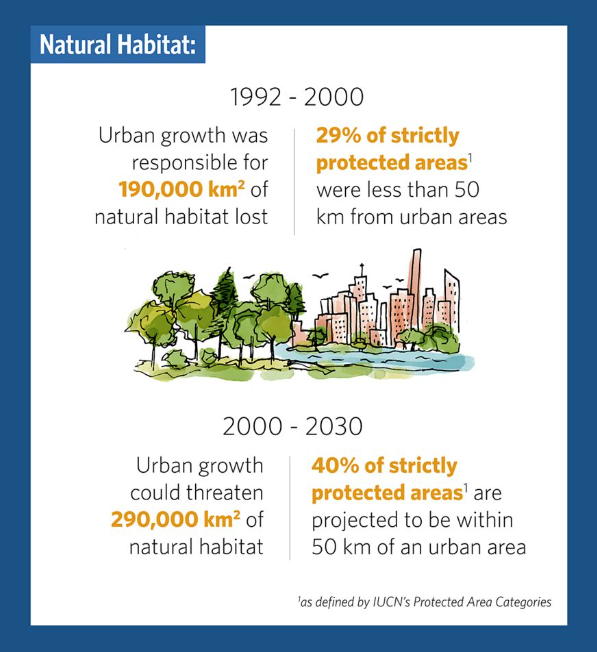

The urbanization trend poses a major threat to several critical ecosystems, including wetlands. Wetlands can play a crucial role in urban biodiversity, and in maintaining ecosystems and the well-being of urban communities. When preserved and sustainably used, urban wetlands can provide cities with multiple economic, social and cultural benefits. During storms, urban wetlands absorb excess rainfall, which reduces flooding in cities and prevents disasters and their subsequent costs. The abundant vegetation found in urban wetlands acts as a filter for domestic and industrial waste and contribute to improving water quality.

As cities grow and the demand for land use increases, the tendency is for development to encroach on wetlands, because they are often perceived as wastelands that can be used as dumping grounds or converted for other land uses.
Urban wetlands are prized assets, not wasteland, and therefore should be proactively conserved and integrated into the development and management plans of cities. The Convention on Wetlands (also known as the Ramsar Convention) is promoting cities that take exceptional steps to protect their wetlands and benefits to people, by giving credit to cities that prioritize their urban wetlands through an accreditation scheme.
The 172 Contracting Parties to the Convention on Wetlands have agreed to the conservation and wise use of wetlands in their territories. Recognizing the importance of cities and urban wetlands, the Convention introduced a Wetland City accreditation scheme in 2015 (Resolution XII.10). This voluntary scheme provides an opportunity for cities that value their natural and/or human-made wetlands to gain international recognition and positive publicity for their efforts. Cities must apply to be accredited and they have to show that they comply with a number of criteria, including exceptional protection, care and wise use of their wetlands through a range of mechanisms such as urban planning and education.
2018
During the first cycle of the City Accreditation Scheme, the 18 cities that qualified for accreditation were announced at the Convention of Wetlands COP13 in 2018. These 18 cities were:
- China: Changde, Changshu, Dongying, Haerbin, Haikou, Yinchuan
- France: Amiens, Courteranges, Pont Audemer, Saint Omer
- Hungary: Lakes by Tata
- Republic of Korea: Changnyeong, Inje, Jeju, Suncheon
- Madagascar: Mitsinjo
- Sri Lanka: Colombo
- Tunisia: Ghar el Melh
The intention is that The Wetland City Accreditation scheme will encourage cities in close proximity to and dependent on wetlands, especially Wetlands of International Importance, to highlight and strengthen a positive relationship with these valuable ecosystems, for example through increased public awareness of wetlands and participation in municipal planning and decision-making. The Accreditation scheme should further promote the conservation and wise use of urban and peri-urban wetlands, as well as sustainable socio-economic benefits for local people.
During the 59th meeting of the Convention on Wetlands Standing Committee on 26 May 2022, the Co-Chairs of the Convention on Wetlands Independent Advisory Committee on Wetland City Accreditation announced that 25 applicant cities had been accepted in recognition of their exceptional efforts to safeguard urban wetlands for people and nature.
Congratulations to the cities that have been accredited! One of the cities, Cape Town, is one of the pioneer CitiesWithNature – a global partnership initiative that recognizes and enhances the value of nature in and around cities across the world. The 2022 accredited cities are:

2022
During the second cycle of the City Accreditation Scheme, 25 cities qualified for accreditation and were announced during the Convention on Wetlands Standing Committee of May 2022. These newly accredited cities will be formally recognized during the COP14 of the Convention on Wetlands, to be held in November 2022.
These 25 cities are:
- Canada: Sackville
- China: Hefei; Jining; Liangping; Nanchang; Panjin; Wuhan; and Yangcheng
- France: Belval-en-Argonne and Seltz
- Indonesia: Surabaya and Tanjung Jabung Timur
- Islamic Republic of Iran: Bandar Khamir and Varzaneh
- Iraq: Al Chibayish
- Japan: Izumi and Niigata
- Morocco: Ifrane
- Republic of Korea: Gochang; Seocheon; and Seogwipo
- Rwanda: Kigali
- South Africa: Cape Town
- Spain: Valencia
- Thailand: Sri Songkhram District
Forests sequester about one third of greenhouse gas emissions, yet only a handful of U.S. communities include trees in GHG inventories.
Washington, D.C. (August 19, 2019) – Today, ICLEI–Local Governments for Sustainability USA (ICLEI) unveiled new guidance that enables U.S. cities and counties to include forests and trees within their greenhouse gas (GHG) emissions accounting, a key activity to ensure representation of local forestry and land use consideration in climate action planning. Developed in partnership with the Woods Hole Research Center and World Resources Institute (WRI), and funded by Climate and Land Use Alliance (CLUA) and Doris Duke Charitable Foundation, the Forest and Land Use Appendix to ICLEI’s U.S. Community Protocol for Accounting and Reporting of Greenhouse Gas Emissions will help fill a critical gap in enabling communities to develop climate action related to land management at a local level.
Forests and trees sequester about a third of the greenhouse gas emissions that humans emit every year; however, a study conducted by ICLEI showed that 60 percent of U.S. community respondents did not include forests or trees in their greenhouse gas inventories due to a lack of guidance on how to do so.
“Failing to include forest and trees within U.S. climate action plans — which serve as such a critical component to meeting global climate mitigation goals — simply due to lack of available guidance was a huge missed opportunity,” said Angie Fyfe, Executive Director, ICLEI USA. “The U.S. has some of the best data on land use, we couldn’t let limited expertise on how to put these numbers together be the cause for inaction.”


More than 3,500 people have downloaded The U.S. Community Protocol since 2012. The Forest and Land Use Appendix of the Protocol provides, for the first time, guidance to U.S. communities for estimating the emissions and removals from forests. The Appendix also considers “trees outside forests”, including urban trees and trees in croplands, which are often overlooked in national assessments.
The protocol was piloted with Montgomery County, Maryland; Los Angeles County, California; and Whatcom County, Washington; representing the dramatic spectrum of climate and land cover across the country.
“Montgomery County jumped at the opportunity to explore the sequestration benefits associated with trees and forests,” said Marc Elrich, County Executive, Montgomery County, Maryland. “Given our aggressive GHG reduction goals of 80 percent by 2027 and carbon neutrality by 2035, increased sequestration must be in the mix of strategies we employ. The new protocol also has prompted us to think more deeply about natural climate solutions ranging from reducing the heat-island effect to increasing sequestration in the agricultural sector.”
“The protocol provides a baseline for communities to start acknowledging the climate benefits that come from leaving forests and trees standing, increasing tree canopy cover in cities and incorporating trees into agricultural landscapes,” said Nancy Harris, Forest Program Research Manager at World Resources Institute and co-author of the protocol. “Having this guidance at a sub-state level is critical, given most decisions around land use are made at a very local scale.”
ICLEI USA has revised its ClearPath GHG emissions management software tool with new calculators that will allow communities to develop GHG inventories with land use in mind from the outset and is encouraging its member communities to see the new guidance to consider how forests and trees can be integrated into climate action plans.
Download the U.S. Community Protocol for Accounting and Reporting of Greenhouse Gas Emissions
With the release of the Intergovernmental Science-Policy Platform on Biodiversity and Ecosystem Services (IPBES) global assessment, it is increasingly clear that biodiversity and natural ecosystems play a crucial role in maintaining the health of the planet, particularly in the face of climate change.
The natural environment provides many valuable and free services that contribute directly to human well-being and livelihoods. In a rapidly urbanizing world, cities and their surrounding areas will play a key role in leading action to protect the natural ecosystems that support to human life and vibrant economies.
Recent history has seen the large-scale replacement of natural ecosystems with built up areas, putting cities and their surroundings under increased pressure in terms of resource scarcity, degraded air and water quality, and reduced green space. But this does not have to be the case – local and regional governments are already working to mainstream biodiversity planning into local policies and ensure that the natural ecosystems that support human life are protected.
Natural asset mapping is a first step towards raising awareness of the critical role that nature and natural ecosystems play in supporting healthy and balanced urban life. It is also a key step for local governments to take in order to integrate ecosystem management into urban planning.
How natural asset mapping works
Dar es Salaam in Tanzania is one of nine cities that has worked with ICLEI to map its natural assets through the INTERACT-Bio project. This project supports expanding urban communities in the Global South to improve the utilization and management of nature while providing them with nature-based solutions and associated long-term benefits.
These cities used a two-step methodology for the mapping process. First, high-resolution remotely sensed spatial data was acquired from the European Space Agency’s Sentinel 2 mission and the project team worked closely with GeoTerraImage to develop land cover classes that highlight areas which provide ecosystem services, such as wetlands, mangroves, grasslands and woody vegetation. This analysis resulted in a detailed baseline spatial dataset that defines 12 different classes of landcover and can be used to generate a variety of mapping outputs and analytics.
The second step combines the data and information generated from the remote natural asset mapping process with local spatial information about urban nature features and the state that they are in, scientific studies and a deliberately participatory and iterative process to gather input from local experts and city officials.
Through natural asset mapping that combines customized earth observation data and information with input from local experts and stakeholders, local governments can make informed decisions about managing and investing in green space and green and blue infrastructure that enhances resilience and nature-based development.
The value of nature in Dar es Salaam
Dar es Salaam has many important natural areas that support the city and its people. Its natural assets range from beaches, rivers, mangroves, coastal and Afromontane forests to wildlife such as birds, bats, monkeys, rich marine life, and coastal plants and animals.
With careful planning, these natural resources can be protected, enhanced and even expanded to sustainably provide many benefits. These include enhanced fresh water provision, food, timber, jobs, cooling of the city, reduced air pollution, protection against natural disasters, opportunities for tourism, recreation and relaxation, and a sense of place.
During the mapping process in Dar es Salaam, city representatives and local experts identified challenges such as dwindling green open spaces, over exploitation of natural resources like indigenous trees and urban heat island effect as key priorities for the city to address.
The natural asset mapping pulled on local knowledge and research and yielded a collection of thematic and explanatory maps that make the case for the importance of green open space in the city and establishing a record which the city can work from to develop policy and practice.
The strength of this approach is that the maps can be overlaid to expose areas where investment in greening can deliver and optimize desired benefits, such as cooling and air pollution reduction.
This approach also highlights potential partnerships. For example, the transport sector implements greening as well as the City Council. The maps identifies areas where these sectors can collaborate and co-invest their greening budgets to optimize urban ecosystem benefits.
A summary document with key maps and information, with policy and action recommendations was developed as a tool that will support they city in making strong arguments for investing in urban nature and nature-based solutions.
The thematic mapping also formed the basis for the development of an illustrated poster of Dar es Salaam that show the natural assets in the city in an attractive and accessible format. The purpose is to create awareness of the presence and value of nature in cities and to inspire officials and the public to protect and benefit from urban nature.
This article originally appeared on CityTalk, a blog by ICLEI.

